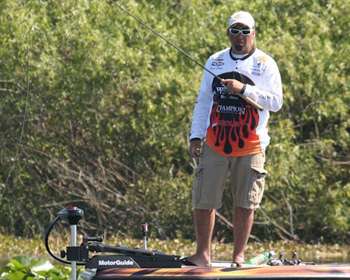
With all the different choices in baitcast reels available today, it's easy to overlook the importance of gear ratio and how it can impact a day's fishing excursion. In fact, many anglers think that the only thing a reel does is get the bait down to the strike zone and bring it back to the boat.
Elite Series pro Jason Quinn begs to differ. After a full day of winding a deep-diving crankbait, the right retrieve ratio can make the difference between being exhausted and still having some energy to burn.
"If I'm fishing a deep crankbait, I like to use a 5:1 ratio reel," he says. "With a lower gear ratio, the diving lip on the bait is going to be doing all the work, and it'll get down to its maximum depth."
Besides slowing the retrieve, Quinn explains that the lower gear ratio allows him to prevent fatigue — a factor he has to consider given his 8-to-5 job involves winding a reel handle.
"If you use a fast, 7:1 reel, you're just going to wear yourself out," he explains. "A 5:1 ratio is perfect for deep running baits," he adds, "but not necessarily for shallow-running baits."
In a shallower scenario, where he's fishing around visible cover, Quinn points out that a 6:3:1 ratio is the preferred selection.
"I'm not really worried about depth in this situation," he says. "Plus, when you're fishing shallower, bass will have a tendency to push the bait a little bit when they hit it. That little bit of extra gearing helps me pick up slack line more quickly."
For flipping shallow cover, Quinn reveals that manufacturers have yet to design a reel with a high enough gear ratio to suit him.
"I'd use a 10:1 ratio if they made one for flipping," he says. "When you're flipping, you often don't even realize you've gotten a bite until the line has move 5 feet. You want a reel that's going to pick up as much line as possible in that situation."
The same can be said when throwing topwaters.
"A 7:1 ratio reel will get the deal done when you're throwing topwater baits because you can move a ton of line really, really quickly," Quinn says. "If you're using a lower gear ratio, chances are pretty good that you'll miss a lot more fish."
While Quinn is fixed on a specific gear ratio for deep cranking, flipping and topwater applications, the right ratio for jerkbait fishing is somewhat puzzling to the South Carolina pro.
"I still haven't figured out why it is, but a higher gear ratio should be better, but it's not. You'd think you'd be able to pick up more slack and stay in better contact with the bait," he says. "But I know I get more bites using a 5:1 ratio reel when I'm throwing a jerkbait and it just doesn't make any sense. The best that I can figure is that it's allowing the bait to sit in the strike zone a little longer."
For the weekend angler who isn't likely to have a rod locker full of different reels to choose from, Quinn suggests a smaller array of reels.
"I limit my gear selection to how I plan on fishing, or how I fish the most," he says. "A 6:3:1 reel is pretty much the workhorse for me. You can always slow it down a little if you're throwing a deep-diving crankbait, or speed it up if you're burning a spinnerbait or throwing topwaters. It's just a good all around reel that works in most any situation."
(Provided by Z3 Media)




